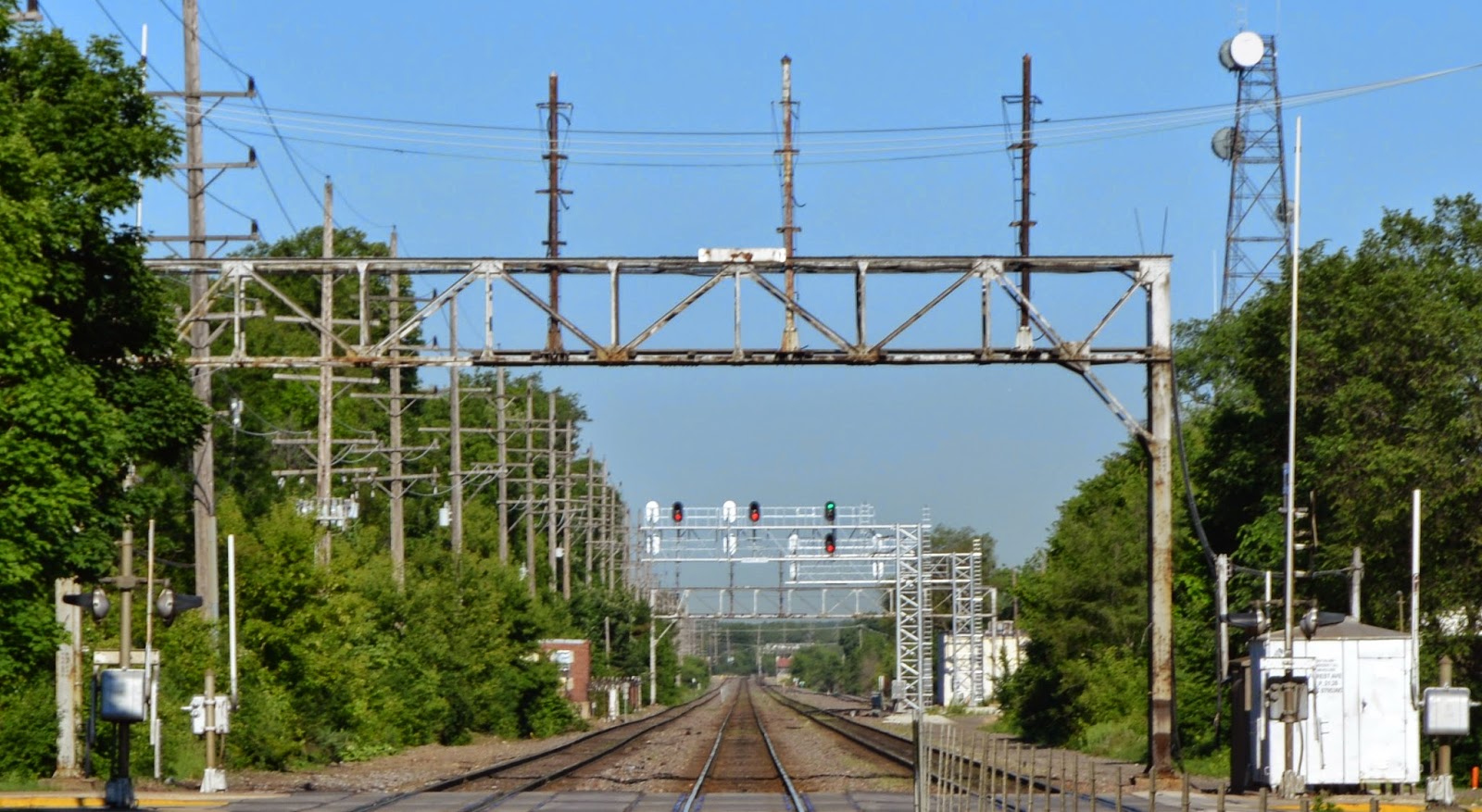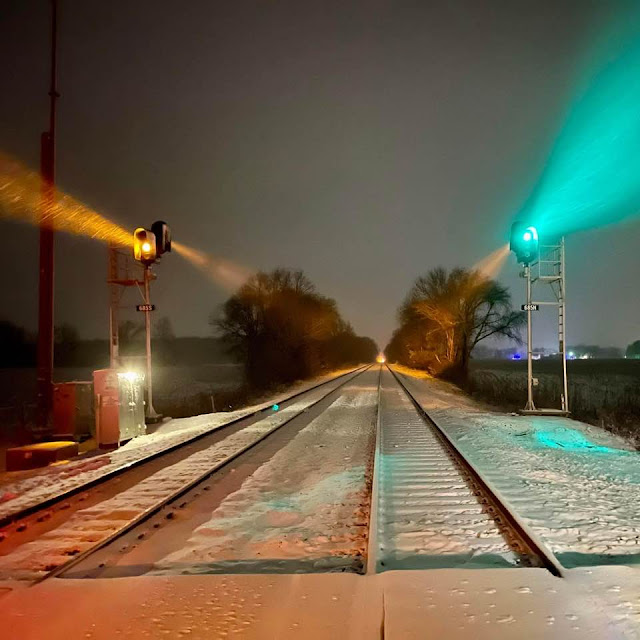 |
| Mike Matalis,2009 |
 |
| 20140607 0007 |
Between the lamp housing and the lens of a searchlight is a spectacle. The spectacle is a turret that contains three colored roundels. The red roundel is in the middle and the green and yellow roundels are on either side of the red. The reason the red is in the middle is so red is the default aspect if the control electricity for the head is lost. This provides the fail safe feature that the most restrictive aspect will display if control is lost. A signal head uses either two pairs of lens or a single Fresnel lens. [RailroadSignals]
Robert J Della-Pietra posted a photo of some CB&Q searchlights in Naperville, IL in the fog. The fog shows the light is focused into a tight beam aimed at the engineers eyes. I've noticed when looking at the searchlights from a crossing that if I'm not close to the track, I can't see the light. That is another indication of how small the beam of light is. The reason for the tight beam is so that a low wattage bulb can be used since the bulb's output is concentrated on the engineer's eye. The use of a low wattage bulb is important in wilderness locations such as the mountains where the signals are powered by batteries.
| 1939 Aerial Photo from ILHAP |
Mike Matalis has photos during the transition at Hinsdale, Westmont, Fairview, and Main.
Mike Matalis caught them taking down the old signal bride west of Fairview Avenue on 3/30/14. During the weekend of the cut over from the old to new signals, they did not remove the bridge, just the heads. As you can see in the "20140607 0007" photo above, the old bridge and shafts were left after the cut over near Forest Avenue. In these older pictures, note the line of "telephone poles" along the north side of the tracks. They are called "code lines" and they carry the analogue currents that control the signals, switches, and crossing gates. They also carry information from sensors such as track circuits, hot box detectors, dragging equipment detectors, etc. You will see in the more recent pictures that they have been removed along with the old signal bridges and searchlights because the new signaling equipment uses digital information carried on buried fiber optic cables.
Mike Matalis caught them taking down the old signal bride west of Forest Avenue on 10/5/14. Note that the code line along the north side of the tracks is long gone. And he captured the old and new equipment at Westmont.
 |
| BNSF (source) As per the federal mandate, BNSF has installed the PTC infrastructure on all 88 required subdivisions, covering more than 11,500 route miles and 80 percent of our freight volume. We are running hundreds of trains daily with PTC as we test operating in revenue service across our entire mandated territory. |
Marty Bernard has a photo that shows Westmont had more code lines than Downers Grove did.
At the end of 2017, they removed the insulated joints that used to support the old signalling system.
 |
| Dennis DeBruler shared The snow shows how concentrated the beams are. Matt Lasayko photo. Jan 1, 2022 Brian Voss Technically they're color light signals, not the single lens searchlights (which I highly favored when I was an engineer).. an excellent photo nonetheless! Also of note, the opposing signals both appear to be glowing an 'approach' (yellow), indicating there's no traffic lined up or blocks occupied in either direction. A brilliant composition. Dennis DeBruler  Brian Voss Good point. I removed the adjective "searchlight" in my comment. Now that I'm thinking about it, I don't know what to call one of the the lights in a tri-colored signal. Brian Voss Dennis DeBruler no worries! Each signal is displaying a unique aspect. Where I worked (Chicago area) the left signal would typically be called an 'approach' and the right signal is 'clear'. If a signal were red, typically a number plated signal would be considered 'restricting' or restricted proceed. |
The (Metra+CP)/Milwaukee tracks still have searchlights over 3 of their tracks. In the right background we can see that only two of the tracks were converted to PTC.
 |
| Robby Gragg Flickr Dennis DeBruler posted You can tell that there has been more snow in March than there was in February this year. Note the switch heater in the foreground. |
When we had a big mass coronal ejection in May 2024, I saw a lot of photos of the Northern Lights. This is the best one I saw from the lower latitudes.
 |
| Shaun Andrews posted Roger Riblett shared |
No comments:
Post a Comment